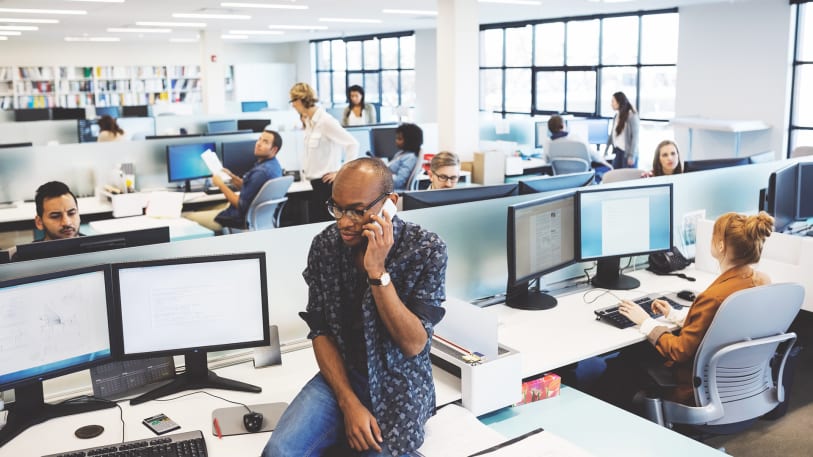Recent research into hot-desking — the sharing approach that’s found a home in countless co-working spaces — revealed “flexible” and “activity-based” office arrangements could actually hurt, rather than help, employee trust and satisfaction, it raised questions about whether the most popular office setups are the most effective.
Trading Floors to Fintech
Blending Tradition and High Tech in the Finance Workplace
The finance sector continues to transform as it adapts to several, major forces, including altering regulations, consumers’ increased use of digital banking and demands for increased cybersecurity. Following the 2008 recession, large financial institutions changed where they focus their investment dollars, namely less in personal lending and more in wealth management and investment banking. Also, consumers’ expectations that transactions can happen anywhere, anytime, means institutions must attract and retain a variety of tech workers and compete with top tech companies for talent. Meanwhile, emerging financial technology, or fintech, companies continue to research and develop digital solutions to nearly every aspect of banking and finance, often partnering with larger firms and companies.
What To Do When The Biggest Office Distraction Is Your Coworkers
When your biggest office distractions aren’t things like Slack or meetings or your own Facebook account but other people, your options for getting back on track may feel limited. The bad news is that they are pretty limited; when you get down to it, there are really only two potential courses of action open to you. The good news, on the other hand, is that you don’t need to learn a complicated mind hack to help you focus or to download yet another productivity app. Here’s a straightforward guide to prevent your irritating colleagues from driving you crazy.
How wellness is influencing the workplace
Performance certifications like LEED, Passivhaus, and Green Globes have changed the way we think of baseline environmental concerns, but a new set of rubrics looks to build on those standards. The concept of wellness in many ways is an extension of the environmental movement, as it expands the ideals of building performance to the human experience.
Countercultures in the Workplace
The terms “workplace” and “culture” are almost synonymous in today’s business vernacular. Companies devote countless hours, resources, and strategies to defining and implementing distinct workplace cultures that support their goals, build their brands, and affect every aspect of the work environment—including the power to attract, engage, inspire, and retain talent. Culture may not always mean a static end game; instead it may be a shifting variable that is encouraging change and aligning with new behaviors and productivity. Take Google for example, “…Google doesn’t view their culture as a “set it and forget it” program. They’re actively changing and maintaining it, because it’s crucial to their success. “
Watch: Jim Keane on Fueling Sustainable Innovation
Steelcase has been in business for more than 100 years, creating places that unlock human promise for the world’s leading organizations. But what motivates our company and clients isn’t our products and what they can do — we’re motivated by people and what we can do together.
Actions form the foundation of culture, and we believe building a strong, sustainable business depends on getting culture right. We’re committed to unlocking human promise by moving from words to action and pursuing sustainability initiatives built on inclusion.
Office vigilantes fail in mission to be a force for good
They are either the heroes of the office — safeguarding the hygiene of the fridge and diligently reporting any wrongdoing — or irritating snitches, depending on your viewpoint.
More than half of workers have encountered a “dark knight employee” at some point in their career, a study indicates.
Researchers from the University of Toronto and the University of British Columbia found that 18 per cent were working with one of these office vigilantes and that 58 per cent had known one during their career.
Inspirational office design: A way to retain millennials
Over the past year, I’ve had numerous conversations with clients about how to hire, inspire and retain their millennial employees. It seems many leaders I work are struggling to find the “right” answer, but there are as many answers to this question as there are industries, offices and jobs.
People are great: a conversation with James Woudhuysen on the future of work
At a recent conference at the WWF’s Living Planet Centre in Woking staged by the office furniture firm Kinnarps, I had an off the cuff chat with James Woudhuysen who had just delivered one of his typically entertaining, erudite and challenging talks on the future of work alongside equally renowned speakers such as Philip Tidd and Namrata Krishna from architecture firm Gensler.
Are We Being Forced into Workplace Happiness?
Wellness programs, free lunches, employee yoga. There's lots of ways companies try to create a sense of happiness and well-being for employees. In fact, many companies have large teams dedicated to it and spend millions of dollars to make sure their employees are happy. But what if forcing employees into being happy is actually hurting their performance and overall mental health?
Inside Andy Rubin’s futuristic Playground hardware incubator
With titanium 3D printers, electrostatic charge tables, and a giant slide, Playground Globallives up to it’s a name. Here we take you on a tour of Android operating system inventor Andy Rubin’s hardware startup incubator that’s backed by a $300 million fund. Check out how the whimsical space lets scrappy hackers compete with Facebook and Google to recruit top talent. If techies are all Peter Pans, this is the Lost Boys’ clubhouse.
Balancing Introvert & Extrovert Needs In A Workspace – Can It Be Done?
Yes.
In earlier personal and discussion group posts, we talked about what it really means to be an introvert and what it has to do with work. We even found that, regardless of which you identify with, people crave the same types of spaces for group and individual work. We all face the same basic business needs when it comes to interacting with our colleagues. We all need time to focus, collaborate and re-energize.
5 WAYS COWORKING IS BETTER THAN A TRADITIONAL OFFICE
At Arrowstreet Architecture and Design, we think outside the box, literally, when it comes to coworking. In fact, we’re proud to have designed one of the most dynamic coworking space networks in the United States: Brooklyn Boulders (BKB), which features productive environments for users to work and mingle amongst a series of climbing walls. BKB outposts are now active in a variety of old and new spaces, from a converted warehouse in Somerville, Mass. to a luxury residential building in Long Island City, N.Y.
THE WORKPLACE IS THE NEW CORPORATE COMMUNICATIONS PLATFORM
When you think of corporate communications, you probably picture traditional channels ranging from public relations, advertising, and social media to staff newsletters, intranets, and similar channels.
Now look around you. Chances are, you’re looking at a powerful communications platform that businesses often overlook: their very own workplace.
Nowadays, when you walk into a store that’s filled with static imagery, it doesn’t feel alive. That’s because sweeping technological advances have created a digital world where we expect well-designed spaces to offer dynamic, interactive experiences that immerse us fully in a brand. Why should our expectations be any different for the workplace?
Trends In Workplace Design Focus On Productivity, Occupant Satisfaction
After decades of research and post-occupancy evaluations, the impacts that workplace design can have on employee productivity, satisfaction, recruitment, and retention are well-documented, understood, and accepted. Those findings have inspired numerous innovations in workplace design, from more daylighting and shared or collaborative spaces to technology-enabled and -enhanced work areas.
But how has workplace design evolved recently to meet the needs and requirements of a new generation of employees, and to address the ever-changing ways in which people wish to work? Moreover, what’s driving the latest innovations?
Office Design: The Cost of Doing Too Little
Offices are more than just the furniture. Lighting, functionality and design are all important factors in the overall productivity of the office. Don’t just sell furniture; sell a new fresh environment that will directly contribute to the success of the employees. This is a great inforgraphic that breaks down all of the necessary components that should be considered when planning your office design.
Physical location, proximity of employees changes productivity
Research, performed between Cornerstone OnDemand, a global leader in cloud-based talent management software, and researchers at Harvard Business School, has uncovered how the distance between two employees' desks affects various performance measures. According to the findings of this study, placing the right type of workers in close proximity to each other generated up to a 15% increase in organisational performance.
Big businesses benefit from start-up style working
Big businesses are taking stock of organizational structures which are usually associated with start-ups in a bid to maintain a competitive edge.
As such, many notable corporates launching their own accelerator programs across Europe.
A start-up accelerator is comprised of a number of small, young companies, which receive funding and mentoring, typically within a shared physical space. For start-ups, participating in an accelerator program not only boosts funding resources, but also provides valuable connections with potential investors, buyers, and partners. For more established companies, however, setting up and funding an accelerator can add a dynamic operational layer.
5 Things Millennial Workers Want
Millennials entering the workforce display a markedly different set of preferences from their predecessors, at times confounding the companies striving to attract and retain them. Generational attitudes may be partially responsible for their characterization as disloyal or transitory, but equally culpable are the employers that fail to understand and meet Millennials’ needs.
Headspace: Where Do You Find Yours?
Could lack of choice and access to quiet, focus-oriented space stifle career trajectory, especially those in a creative industry or role? Most offices tend to lack a proper amount of quiet space to focus and clear your head, as well as offer shared social spaces to release, play and teach. In reality we need time and quiet ‘headspace’ between each of these phases for ideas to mature before they take off.

























